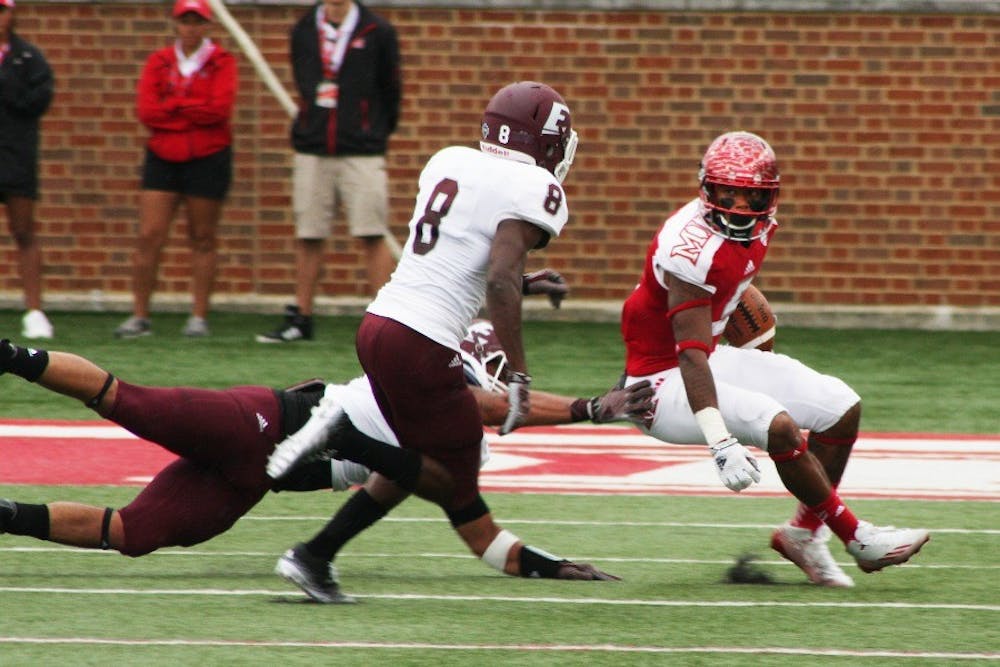By Mary Schrott, For The Miami Student
This year's budget shows that over 50 percent of the $1,860 general fee paid by all Miami undergraduates is going toward intercollegiate athletics.
With the general fee being mandatory, this means each year undergraduates must pay $997 for intercollegiate sports, as well as a combined $350 for the Rec center and Goggin Ice Center, leaving $513 to be allocated to Armstrong, Shriver, Millet, Health Services, Transportation Services, ASG, Lecture Series, more than 240 other student organizations and several other services.
Current senior and vice president of Student Organizations, Nathan Lombardi, is heading an eight-person task force of students and faculty aiming to address and alter the general fee by 2020. Lombardi said the money paid toward intercollegiate sports mainly supports student-athlete scholarships.
"I think it's a disproportionate allocation of the student fee away from areas that create tangible student life on campus," he said.
The other areas of tangible student life Lombardi alludes to are MAP events, like Spring Fest, as well as the Lecture Series, an organization he describes as "extraordinarily successful."
Though Lombardi said he supports Miami's intercollegiate athletics, he believes the money and energy being spent on sports doesn't match the culture of Miami, and he cites low attendance as evidence.
"You can't force a cultural change on a campus, you have to move with whatever cultural direction is going on," Lombardi said.
While Lombardi wants to see change in the general fee's focus on intercollegiate athletics, Miami's vice president of finance, David Creamer, believes intercollegiate athletics are an important part of the college environment.
"This is not new," Creamer said. "Intercollegiate athletics have always been supported by student fees."
What Creamer said makes Miami's fee allocations stand out as an outlier is a result of its size.
"We are called a mid-major, and the amount that we spend on athletics is a fraction of what would be spent at the five major conferences," Creamer said.
Enjoy what you're reading?
Signup for our newsletter
Though the fees Miami charges students may be controversial, Creamer feels they ultimately even out for students and provide each individual a rewarding college experience.
"We don't try to provide one specific educational experience for every student," Creamer said. "We hope to provide enough variety and options that your goals and expectations are met and a student who is very different from you hopefully has the same outcome that their unique goals and expectations are being met."
Although attendance at Miami sporting events is a small percent of the student body, many students, like sophomore Nicole Waker, specifically enjoy attending Miami hockey games.
"Going to the games adds a sense of community around school, and it's fun to support a school team that does really well," Waker said.
Creamer notes that many students share Waker's enthusiasm for supporting school teams.
"We have students who line up waiting to get into the hockey game and it's a very important part of their experience here," Creamer said. "Is that true for every student? Absolutely not, some couldn't figure out why they would even go to the game, let alone wait up all night to go."
For the student's who don't enjoy intercollegiate sports, Creamer says there is still the potential for them to benefit from the services the general fee pays for.
"It's a matter of what you take advantage of and if these things just happen to be things that you enjoy and participate in then you probably will get the full benefit."
In regards to dissecting the worth of each individual aspect of the budget, Creamer believes the outcome is greater than the details.
"Often people try to look at each granule [of the budget fee]," Creamer said. "But the more we try to standardize Miami, the less success it will have in meeting the different expectations our students have."




